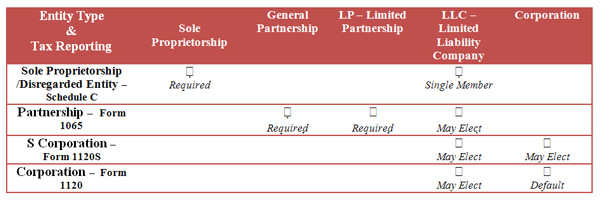Business Structure & Tax Basics Every Business Owner Should Know
Over the decades of helping closely held business owners, I remain amazed at how many misconceptions and myths exist when it comes to the basics of business entities and how they are taxed. Hopefully this overview will shed much needed light and clarity to key information every business owner should know.
Corporate 101
As a basic matter, it is important to understand that business entities are “born” (i.e., formed) at the state level under the relevant state statutes. They are not formed under federal law. Although there is some slight variation amongst the states, state laws generally provide for five types of entities:
- sole proprietorships;
- general partnerships;
- limited partnerships;
- limited liability companies; and
- corporations[1].
Each of the five business entities is summarized below with their advantages and limitations. Because state law governs their creation, some variations will exist. For purposes of this article, the concepts should be universal.
Sole Proprietorships
A sole proprietorship is simply an individual who operates a business enterprise under either their individual name or under a trade name. Depending upon state law, an individual may also include a husband and wife owned business. Often this is how closely-held businesses are established. A sole proprietorship is not recommended because the individual owner is solely responsible for all activities of the business. Their personal assets are subject to creditor claims and potential liabilities created by the business operations.
General Partnerships (GP)
A general partnership is created when two or more people enter into business for a profit. General partnerships may be formed by a simple handshake. Identical to a sole proprietorship in asset exposure, there is no protection of personal assets from the actions of the business. Accordingly, a general partnership is rarely a recommended form in which to conduct a business.
Limited Partnerships (LP)
A limited partnership is a variation on a traditional general partnership, and one that provides limited liability for some of the partners. A limited partnership has two types of partners: general partner(s) and limited partner(s). A limited partner’s personal exposure to the activities of the business is generally
limited to their investment in the LP. A general partner, on the other hand, is responsible for the activities of the business personally. Their personal assets are subject to creditor claims and potential liabilities created by the business operations.
Limited Liability Company (LLC)
A limited liability company is a separate legal entity organized under state law. They are very similar to partnerships in their form. However, unlike partnerships, LLCs provide limited liability protection for all members of the LLC (they are similar to corporations in that regard). The owners of an LLC are referred to as members and are generally not personally responsible for activities of the LLC. LLCs may be managed by its member(s) or by one or more Manager(s). In order to maintain legal independence from its members, certain rules must be followed.[2]
Corporations
A corporation is incorporated under state law and is also a separate legal entity able to act on its own behalf. As with the LLC, corporate shareholders (the owners) are generally not personally responsible for the activities of the company. Corporations are managed by the Board of Directors who elect the Officers annually to run the day-to-day operations. Again, in order to maintain legal independence from its shareholders, certain rules must be followed.[3]
Tax 101
The aforementioned business entities are taxed in one of two ways: either at the entity level in which the company is responsible for paying and remitting the tax on company profits, or as a “pass-through” entity – meaning that the owners of the entity are responsible for income tax on the company’s profits. The determination of whether an entity is taxed as at the entity-level or as a pass-through entity is determined by (1) the type of entity formed under state law, and (2) whether any elections have been filed by the business owners.
Under current Federal law, there results in four possible filing methods[4]:
- as a sole proprietorship (Schedule C of Form 1040);
- as a partnership (Form 1065) ;
- as a C Corporation (Form 1120); or
- as an S Corporation (Form 1120S).
Sole Proprietorships (Schedule C – Form 1040)
A sole proprietorship has the simplest filing requirements. Instead of filing a separate income tax return for the business, the company’s revenues and expenses are reported on Schedule C of the individual’s income tax return (Form 1040). The profits from the business are taxed using individual tax rates. In certain states, married couples are able to file their business activities on Schedule C (typically in a community property state). As an aside, if activities are comprised of rental property income or farming operations, then Schedule E or Schedule F, respectively, would be filed in lieu of Schedule C.
A single-member LLC that is owned by an individual is also taxed as a sole proprietorship unless that individual elects to be taxed as either an S corporation or a C corporation pursuant to the “check-the-box” rules under Federal tax law. This is the case because a single-member LLC (absent an election otherwise) is disregarded for federal income tax purposes (and generally for state income tax purposes as well). Although a single-member LLC is taxed in the same manner as a true sole proprietorship, the LLC continues to provide liability protection for the business owner.
Partnerships (Form 1065)
General partnerships and limited partnerships are generally taxed in the same manner, and are required to report the business revenues, expenses, assets and liabilities on Form 1065. The partnership is a pass-through entity, so the partnership does not pay tax on the business income. Instead, each partner receives a Form K-1 that provides the necessary information from the partnership return for that partner’s share of the income to be reported on their individual tax return. The individual partner is then responsible for income tax on their share of the partnership’s income.
A multi-member LLC is also taxed as a partnership for federal and state purposes, absent an election for the LLC to be taxed as either an S corporation or a C corporation. Again, as with a single-member LLC, it is important to understand that a multi-member LLC that reports its income and expenses as a partnership continues to provide liability protection for its individual members.
C Corporation (Form 1120)
Any entity formed under state law as a corporation will be taxed as a C corporation for federal and state income tax purposes, absent an election to be taxed as an S corporation. An LLC (whether single-member or multi-member) can also elect to be taxed as a C corporation by filing Form 8832 with the IRS. A C corporation reports its income, expenses, assets, and liabilities on Form 1120. Unlike sole proprietorships, partnerships, and S corporations, a C corporation is a separate taxpaying entity and the C corporation will be responsible for income tax on the profits earned by the business. Moreover, the corporate profits are subject to tax again when the business profits are distributed to the shareholders as a dividend. This potential “double-tax” is a significant disadvantage of operating a business as a C corporation.
S Corporation (Form 1120S)
An S Corporation is simply an entity formed as a corporation under the appropriate state law and for which the shareholders have affirmatively elected the company to be taxed as an S corporation by filing Form 2553. An LLC (whether single-member or multi-member) can also elect to be taxed as an S corporation. Unlike a C corporation, an S corporation is not generally a taxpaying entity. Instead, as with a partnership, each owner receives a Form K-1 with their share of profits/losses. Those profits/losses are then reported and taxed on the individual tax return. Some restrictions exist for S Corporations, including the type of shareholder, a limitation to one class of stock, and the number of shareholders. Additionally, no ownership may be held by nonresident aliens.

So Which Entity & Tax Structure Are Best For Your Business?
All too frequently business owners consider administrative ease first when making decisions concerning business and tax. Unfortunately, this mistake may prove tremendously detrimental. In other cases, one entity form may be best for a business at its inception, but a different form may be ideal as the company grows and assets and expenses increase.
There is no single correct answer as to the optimal structure for every business. Instead, the ideal structure will be dependent on a multitude of factors – including the nature of the business, the number of shareholders, the states in which the business operates, the amount of assets held in the business, the type of assets used in the business, whether business holds substantial intellectual property, the profitability of the business, the number of employees, and the succession and estate planning goals of the business owners. And the answer is not limited to a single entity. Because each of the entities has some disadvantages from either an asset protection perspective or a tax perspective, the ideal business structure may be a multi-entity structure. A multi-entity structure is often utilized to gain the advantage of multiple entity types while minimizing the disadvantages of each type of entity.
Ultimately, the determination of the optimal structure for any business is a very sophisticated process that involves careful consideration of a large number of asset protection and tax factors in light of both short-term and long-term goals. If you are considering changing your business structure, or are unsure as to whether your current business structure provides the maximum benefits for you, I would recommend that you consult a tax advisor with an expertise in business structuring and corporate reorganizations to obtain a comprehensive analysis of your businesss.
[1]In addition to the five basic structures, there are certain special structures for professional organizations.

